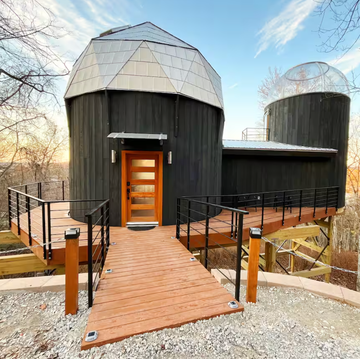1Ghost Ranch, New Mexico
 Wirestock//Getty Images
Wirestock//Getty ImagesGhost Ranch is an education and retreat center located in Abiquiu, a village in northern New Mexico. It is nestled in the desert amidst the red and yellow Piedra Lumbre cliff formation, offering a beautifully colorful view and a wide range of outdoor activities to participate in, from star tours and astrophotography classes.
The 21,000-acre ranch was once home to the American visual artist, Georgia O'Keeffe. It has a rich history that involves once being a dude ranch and one or two ghost stories that helped earn its name. The ranch sits between two major New Mexican Cities (Albuquerque and Santa Fe), but it’s far enough from both locations that most areas are entirely devoid of light pollution, making it a perfect place to see the stars.
2Death Valley National Park, California
 Matt Anderson Photography//Getty Images
Matt Anderson Photography//Getty ImagesDeath Valley is a desert that spans across eastern California and part of Nevada, and Death Valley National Park is a protected area within it.
Every year, a group of research organizations and government agencies like NASA and the Ames Research Center collaborate with the Death Valley Natural History Association to host the Death Valley Dark Sky Festival. The weekend-long event celebrates the valley's dark skies through a series of daytime and nighttime programs, like guided field walks, auditorium presentations and telescope viewings.
Death Valley is known for extreme desert environments like high temperatures and dryness. So make sure you stay hydrated when visiting.
Advertisement - Continue Reading Below
3El Morro, Puerto Rico
 littleny//Getty Images
littleny//Getty ImagesCastillo San Felipe del Morro, also known as “El Morro,” is a 16th-century fortress located in Old San Juan, Puerto Rico. It was built by the Spanish to protect the island from sea invasions and was used as a U.S. Military base during both World Wars. Today, the monument is a popular tourist attraction.
Sociedad de Astronomía del Caribe (Astronomy Society of the Caribbean) regularly hosts stargazing nights at El Morro where they provide guests with telescopes and host other stargazing events.
4Lowell Observatory, Arizona
 Nicholas Klein//Getty Images
Nicholas Klein//Getty ImagesThe Lowell Observatory is an astronomical observatory in Flagstaff, Arizona. Founded in 1894, it is one of the oldest observatories in the United States. Amongst its accomplishments is the fact that Pluto was discovered there in 1930.
General admission includes guided tours, 150+ exhibits, theater shows and performances. Rooftop stargazing is also included in the general admission ticket and is available every day except Tuesday.
Advertisement - Continue Reading Below
5Point Udall, St. Croix
 Onomitra Ghosh / 500px//Getty Images
Onomitra Ghosh / 500px//Getty ImagesPoint Udall, located in East End, St. Croix (U.S. Virgin Islands) is away from commercial and residential areas making it devoid of light pollution, and the best place on the island to see the stars. Plus, it's by the sea so you can hear waves crashing while you look up into the wonder of the sky. As a bonus, eastern St. Croix comes with beautifully scenic hiking trails and beaches, all of which can be great places for stargazing.
6Zion National Park, Utah
 fotoVoyager//Getty Images
fotoVoyager//Getty ImagesZion National Park is Utah’s first national park. Surrounded by massive sandstone in shades of cream, red and pink, it's a natural beauty you want to see. The park also tries to avoid using artificial light, making this place perfect for stargazing. They host stargazing tours and offer additional activities like hiking, horseback riding and fishing nearby.
You can even take in the sky all night long. The park offers campgrounds in case you can't take your eyes off the sky and want to spend the night. Simply book a reservation ahead of time.
Advertisement - Continue Reading Below
7Cherry Spring State Park, Pennsylvania
 Shawn Grenninger / 500px//Getty Images
Shawn Grenninger / 500px//Getty Images 8Craters of the Moon National Monument and Preserve, Idaho
 Stephen J Taylor//Getty Images
Stephen J Taylor//Getty ImagesCraters of the Moon is a national monument and national preserve in the Snake River Plain, between the Idaho towns of Arco and Carey. It encompasses three major lava fields, making it home to many volcanic features such as basaltic lava, tree molds and lava tubes. In 2017, Craters of the Moon was designated an International Dark Sky Park.
The monument hosts star parties every summer and fall, during which volunteers from the Pocatello Astronomical Society provide telescopes and sky viewing tools. You can also plan your own independent visit. Reservations aren’t required.
Advertisement - Continue Reading Below
9MaunaKea, Hawai’i
 blake81//Getty Images
blake81//Getty ImagesMaunaKea is a dormant volcano and the highest point in Hawai’i. You can visit the Mauna Kea Visitor Information Station and enjoy stargazing on your own, or you can also book a tour.
You can join the University of Hawai'i's Center for Munakea Stewardship at the Maunakea Visitor Information Station (VIS) on any night to see the stars for free.
10Chena Lake Recreation Area, Alaska
 Daniel A. Leifheit//Getty Images
Daniel A. Leifheit//Getty ImagesChena Lake Recreation Area is a campground in Badger, Alaska. Chena Lake has two parks: the Lake Park and the River Park. Both have campground facilities that can be excellent stargazing spots for visitors. Additionally, the Aurora Borealis (also known as the Northern Lights can also be seen from the Chena Lake Recreation Area.
Day visits to Chena Lake are free, but if you want to camp to see get the best out of the beautiful night sky, fees apply ($5-30 depending on the camping type).
Advertisement - Continue Reading Below
11Beaver Islands Wildlife Research Area and International Dark Sky Sanctuary, Michigan
 Copyright Lorenzo Montezemolo//Getty Images
Copyright Lorenzo Montezemolo//Getty ImagesThe Beaver Islands State Wildlife Research Area (SWRA) is a network of islands in Lake Michigan. It mainly includes land on Beaver Island, along with several smaller islands such as Garden, High, Hog, North Fox, and South Fox Island. In 2024, the SWRA was named an International Dark Sky Sanctuary, making it Michigan’s first.
Several night sky activities are offered at Beaver Island, including telescope night sky, meteor shower and new moon viewings — which are ideal for observing the Milky Way and other astronomical objects.
12Grand Canyon National Park, Arizona
 Sapna Reddy Photography//Getty Images
Sapna Reddy Photography//Getty ImagesAnother designated International Dark Sky Sanctuary, Grand Canyon National Park in Northwestern Arizona, is a beautiful place to visit both during the day and at night. Its red rocks and exposed geological strata reveal thousands of years of history. At night, Grand Canyon offers spectacular stargazing opportunities due to its high altitude and low light pollution.
Night sky events are hosted at Grand Canyon throughout the year. You can check the National Park Service to find out the dates. Additionally, they also host an annual Star Party, a free 7-day event featuring special guests like astronomers and artists. The 2026 star party will take place from June 6 to June 13.
Advertisement - Continue Reading Below
13Headlands International Dark Sky Park, Michigan
 Diana Robinson Photography//Getty Images
Diana Robinson Photography//Getty ImagesThe Headlands International Dark Sky Park is a 50-acre county park in Mackinaw City, Michigan. When visiting, keep in mind that the park does not permit white light as a courtesy to others. They recommend bringing warm clothing since temperatures are always 10 degrees lower than expected due to its proximity to the lake shore.
Special programing like astrophotography, astronomy lectures and night sky tours are offered at The Headlands all year long. Visit Emmet County's website to learn more.
14Cosmic Campground Dark Sky Sanctuary, New Mexico
 TJ Blackwell//Getty Images
TJ Blackwell//Getty ImagesCosmic Campground Dark Sky Sanctuary in Glenwood, New Mexico is known for its 260-degree clear views of the night sky. The nearest source of artificial light is located more than 40 miles away and is across the state line of Arizona.
Cosmic is a wonderful area for independent stargazing. Stay at the campground is free, and all sites operate on a first come, first served basis.
Advertisement - Continue Reading Below
15Lost Trail National Wildlife Refugee, Montana
 Jonkman Photography//Getty Images
Jonkman Photography//Getty ImagesLost Trail National Wildlife Refuge in Flathead County, Montana, is one of the newest National Wildlife Refuges in the United States, having been established in 1999. It is nestled in the Pleasant Valley, which was formed during the last glacial period of North America.
There are several parking areas along Pleasant Valley Road that are great for stargazing. Remember to turn your headlights off as soon as possible to avoid exposure to white light. If possible, get there before sunset.
16Adirondack Park, New York
 Denise Taylor//Getty Images
Denise Taylor//Getty ImagesLocated in New York's Lawrence County, Adirondack Park is the largest publicly protected area in the contiguous United States. Encompassing 6.1 million acres, Adirondack Park is larger than Yellowstone, Yosemite, Glacier, and Grand Canyon National Parks combined.
The Adirondack Sky Center and Observatory regularly organizes public stargazing nights from its roll-off roof observatory. Private stargazing parties are also available via reservation.
Advertisement - Continue Reading Below
17Katahdin Woods and Waters National Monument, Maine
 Diana Robinson Photography//Getty Images
Diana Robinson Photography//Getty ImagesKatahdin Woods and Waters National Monument spans 87,563 acres of mountains and forestland in northern Penobscot County, Maine. The area has several campgrounds you can visit and plan your own independent stargazing.
You can also visit when they're hosting their annual Stars Over Katahdin event, a celebration of the night skies of the Katahdin region where astronomers and enthusiasts gather to observe celestial objects. The next celebration will be on September 27, 2025.
18The High Line, New York
 Christine Wehrmeier//Getty Images
Christine Wehrmeier//Getty ImagesThe High Line is an elevated linear park in New York City. While NYC is one of the U.S. cities with the most light pollution, the High Line partners with the Amateur Astronomers Association, a non-profit that promotes the study of the cosmos. They also provide free telescopes for the guests’ use.
Stargazing at The High Line is available for free every Tuesday from sunset until 30 minutes before the park closes. While the High Line will not provide the same ability to see the stars with the naked eye that some isolated locations would, stargazing in a city like New York is a magical experience that you won’t want to miss out on.
Advertisement - Continue Reading Below
19Cape Cod National Seashore, Massachusetts
 RHONA WISE//Getty Images
RHONA WISE//Getty ImagesEstablished in 1961, Cape Cod National Seashore preserves 43,607 acres on the outer portion of Cape Cod, Massachusetts, featuring a varied landscape that includes beaches, marshes, ponds, and forests.
Cape Cod National Seashore is best for independent stargazing, quiet reflection and night sky photography. Head to Marconi or Newcomb Hollow Beach on a clear night for the best sights.
P.S. Refrain from swimming in these beaches at night since there have been several shark sightings and attacks in recent years.
20Stephen C. Foster State Park, Georgia
 Jacob Cantrell//Getty Images
Jacob Cantrell//Getty ImagesStephen C. Foster State Park is located within the Okefenokee Swamp in Charlton County, Georgia, providing opportunities for visitors to experience the swamp’s ecosystem.
As many Dark Sky parks, Stephen C. Foster State Park has several night sky viewing events and opportunities, like black moon stargazing. Check out their night events calendar to find out when to visit.

Rosamelia is an Editorial Intern at Good Housekeeping. She's also a graduate student in NYU's Magazine and Digital Storytelling program. In her free time, you can find her reading and reviewing books on her bookstagram: amelias_biblioteca.
Advertisement - Continue Reading Below
Readers Also Read
Advertisement - Continue Reading Below
Advertisement - Continue Reading Below


































